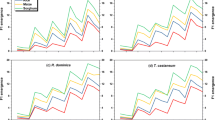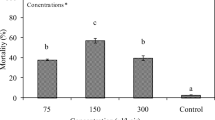Abstract
In this study, the fumigant activity of garlic essential oil and its major components, diallyl disulfide, diallyl trisulfide, and diallyl sulfide, against the stored-product insect, Tribolium castaneum, were investigated. Results from the space fumigation revealed that garlic essential oil and diallyl trisulfide had strong fumigant activities against the adult insect. In glass chambers (10 cm in diameter × 125 cm in height) filled with 10, 20, 30, 40, and 50% volume of rough rice, the fumigant activity of diallyl trisulfide was more potent than that of garlic essential oil. At the concentration of 8 μl/l and 50% filling ratio, to obtain 100% mortality, exposure time of only 4 days was needed for diallyl trisulfide, but a longer exposure time (6–7 days) was required for garlic essential oil. Meanwhile, the fumigant effects on the germination rate of kernels exposure were ascertained. Results proved that there were no side effects for these substances on germination rate of kernels exposed 6 months after fumigation. In addition, the fumigant effect on F1 progeny production in rough rice was also evaluated for garlic essential oil and diallyl trisulfide. The results showed that progeny production was totally suppressed at 4 μl/l of these two substances, either at 10 or 50% filling ratio. The results may provide valuable advances for future fumigant development and possible utility as a fumigant especially as a seed protectant in warehouses filled with grain.


Similar content being viewed by others
References
Abbott WS (1925) A method of computing the effectiveness of an insecticide. J Econ Entomol 18:265–267
Allotey J, Azalekor W (2000) Some aspects of the biology and control using botanicals of the rice moth, Corcyra cephalonica (Stainton), on some pulses. J Stored Prod Res 36:235–243
Arthur FH (1999) Evaluation of an encapsulated formulation of cyfluthrin to control Sitophilus oryzae (L.) on stored wheat. J Stored Prod Res 35:159–166
Barton A, Tjandra J, Nicholas P (1989) Chemical evaluation of volatile oils in Eucalyptus species. J Agric Food Chem 37:1253–1257
Dugravot S, Sanon A, Thibout E, Huignard J (2002) Susceptibility of Callosobruchus maculatus (Coleoptera: Bruchidae) and its parasitoid Dinarmus basalis (Hymenoptera: Pteromalidae) to sulphur-containing compounds: consequences on biological control. Environ Entomol 31:550–557
Ho SH, Koh L, Ma Y, Huang Y, Sim KY (1996) The oil of garlic, Allium sativum L. (Amaryllidaceae), as a potential grain protectant against Tribolium castaneum (Herbst) and Sitophilus zeamais Motsch. Postharvest Biol Technol 9:41–48
Huang Y, Chen SX, Ho SH (2000a) Bioactivities of methyl allyl disulfide and diallyl trisulfide from essential oil of garlic to two species of stored-product pests, Sitophilus zeamais (Coleoptera: Curculionidae) and Tribolium castaneum (Coleoptera: Tenebrionidae). J Econ Entomol 93(2):537–543
Huang Y, Lam SL, Ho SH (2000b) Bioactivities of essential oil from Elletaria cardamomum (L.) Maton. to Sitophilus zeamais Motschulsky and Tribolium castaneum (Herbst). J Stored Prod Res 36:107–117
Isman MB (2006) Botanical insecticides, deterrents, and repellents in modern agricuture and an increasingly regulated world. Annu Rev Entomol 51:45–66
Kimbaris AC, Kioulos E, Koliopoulos G, Polissiou MG, Michaelakis A (2009) Coactivity of sulfide ingredients: a new perspective of the larvicidal activity of garlic essential oil against mosquitoes. Pest Manag Sci 65(3):249–254
Li T, Ito K, Sumi S, Fuwa T, Horie T (2009) Protective effect of aged garlic extract (AGE) on the apoptosis of intestinal epithelial cells caused by methotrexate. Cancer Chemother Pharmacol 63(5):873–880
Liu Z, Ho S (1999) Bioactivity of the essential oil extracted from Evodia rutaecarpa Hook f. et Thomas against the grain storage insects, Sitophilus zeamais Motsch. and Tribolium castaneum (Herbst). J Stored Prod Res 35:317–328
Muller-Riebau F, Berger B, Yegen O, Cakir C (1997) Seasonal variations in the chemical compositions of essential oils of selected aromatic plants growing wild in Turkey. J Agric Food Chem 45:4821–4825
Namazi H (2008) The role of garlic in the prevention of ischemia-reperfusion injury: a new mechanism. Mol Nutr Food Res 52(6):739–740
Papachristos DP, Stamopoulos DC (2002) Repellent, toxic and reproduction inhibitory effects of essential oil vapours on Acanthoscelides obtectus (Say) (Coleoptera: Bruchidae). J Stored Prod Res 38:117–128
Park IK, Shin SC (2005) Fumigant activity of plant essential oils and components from garlic (Allium sativum) and clove bud (Eugenia caryophyllata) oils against the Japanese termite (Reticulitermes speratus Kolbe). J Agric Food Chem 53(11):4388–4392
Park IK, Choi KS, Kim DH, Choi IH, Kim LS, Bak WC, Choi JW, Shin SC (2006) Fumigant activity of plant essential oils and components from horseradish (Armoracia rusticana), anise (Pimpinella anisum) and garlic (Allium sativum) oils against Lycoriella ingenua (Diptera: Sciaridae). Pest Manag Sci 62(8):723–728
Pimentel MAG, Faroni LRD, Guedes RNC, Sousa AH, Totola MR (2009) Phosphine resistance in Brazilian populations of Sitophilus zeamais Motschulsky (Coleoptera: Curculionidae). J Stored Prod Res 45(1):71–74
Prowse MG, Galloway TS, Foggo A (2006) Insecticidal activity of garlic juice in two dipteran pests. Agr Forest Entomol 8:1–6
Rajendran S, Sriranjini V (2008) Plant products as fumigants for stored-product insect control. J Stored Prod Res 44(2):126–135
Ren Y, Mahon D, Graver JVS, Head M (2008) Fumigation trial on direct application of liquid carbonyl sulphide to wheat in a 2500 t concrete silo. J Stored Prod Res 44:115–125
Sahaf BZ, Moharramipour S (2008) Fumigant toxicity of Carum copticum and Vitex pseudo-negundo essential oils against eggs, larvae and adults of Callosobruchus maculatus. J Pest Sci 81(4):213–220
Sfaxi IH, Ferraro D, Fasano E, Pani G, Limam F, Marzouki MN (2009) Inhibitory effects of a manganese superoxide dismutase isolated from garlic (Allium sativum L.) on in vitro tumoral cell growth. Biotechnol Prog 25(1):257–264
Shaaya E, Kostjukovski M, Eilberg J, Sukprakarn C (1997) Plant oils as fumigants and contact insecticides for the control of stored-product insects. J Stored Prod Res 33:7–15
Sousa AH, Faroni LRD, Guedes RNC, Totola MR, Urruchi WI (2008) Ozone as a management alternative against phosphine-resistant insect pests of stored products. J Stored Prod Res 44(4):379–385
Taylor R (1989) Phosphine—a major fumigant at risk. Int Pest Control 31:10–14
Wu CC, Chung JG, Tsai SJ, Yang JH, Sheen LY (2004) Differential effects of allyl sulfides from garlic essential oil on cell cycle regulation in human liver tumor cells. Food Chem Toxicol 42(12):1937–1947
Yang FL, Li XG, Zhu F, Lei CL (2009) Structural characterization of nanoparticles loaded with garlic essential oil and their insecticidal activity against Tribolium castaneum (Herbst) (Coleoptera: Tenebrionidae). J Agric Food Chem 57:10156–10162
Acknowledgment
This work was supported by a grant from National Natural Science Foundation for Young Scholars (No. 30900956).
Author information
Authors and Affiliations
Corresponding author
Additional information
Communicated by J. Riudavets.
Rights and permissions
About this article
Cite this article
Yang, FL., Zhu, F. & Lei, CL. Garlic essential oil and its major component as fumigants for controlling Tribolium castaneum (Herbst) in chambers filled with stored grain. J Pest Sci 83, 311–317 (2010). https://doi.org/10.1007/s10340-010-0300-y
Received:
Accepted:
Published:
Issue Date:
DOI: https://doi.org/10.1007/s10340-010-0300-y




